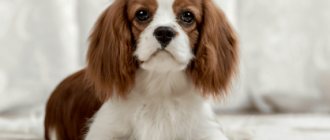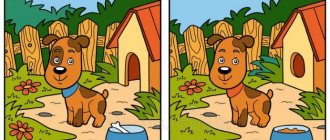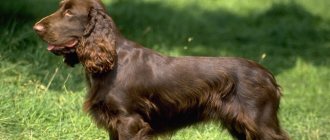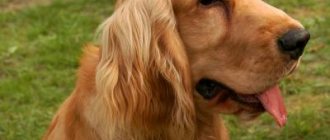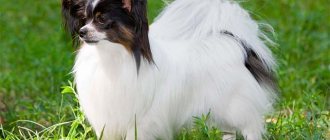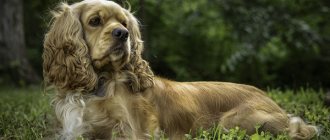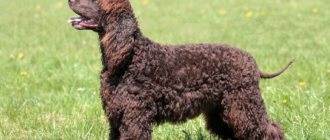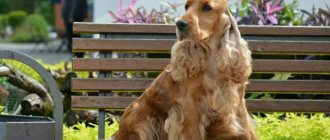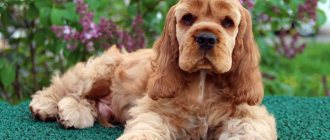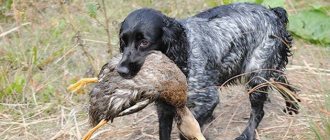| Origin: | Great Britain |
| Usage: | companion |
| Color: | tricolor, ruby, blenheim, black and tan |
| Dimensions: | height 30.5 – 33 cm, weight – 6 – 8.2 kg |
| Lifespan: | 12 – 15 years |
The Cavalier King Charles Spaniel is a toy dog originally from England. This gentle and cheerful pet is called the best companion. It suits everyone - from families with children to single elderly people. The popularity of the breed has not subsided for several centuries due to its flexibility, optimism, sensitivity and beautiful appearance.
Appearance and standard
The description of the breed speaks of the Cavalier as a proportional, strong dog with a large head relative to the body. Males and females are different: the former are stronger and more muscular.
The size is small - height at the withers ranges from 30.5 to 33 cm. The breed standard does not strictly limit weight - the main thing is that the adult dog has a proportional build without signs of exhaustion or obesity. Average weight – 6 – 8 kg.
Frame
The body format is square, sinewy, and the bones are well developed. The back is straight with a convex loin and sloping croup, the shoulder blades are pressed to the back. The chest is deep, the stomach is slightly tucked.
The tail is decorated with wool, with dewlaps. Previously it was cropped, but now it is not cropped. The animal holds it low.
Head
The skull is flat between the ears, with a convex forehead. The muzzle tapers to the lobe, the nose is black. Lips with black mucous. Scissor bite.
The ears stand high, hang down to the sides of the head, and are covered with thick, long hair. The eyes are set low and wide, large, dark in color, bordered by black eyelids.
Limbs
Paws are straight, moderately long. Placed vertically under the body. The front ones are pressed to the chest, the rear ones are slightly pulled behind the hip line.
Paw pads in a ball. Hair grows between and around the toes, forming “slippers.”
Coat
The coat is long, thick, slightly curled. There are featherings on the ears, back of the hips and tail. The characteristics of the breed exclude dogs without dewlaps.
Color
The cavalier's colors deserve special attention. They developed historically. There are 4 types of suit:
Black and tan or King Charles color. The main color is black with bright tan spots above the eyes, inside the ears, on the cheeks, chest, paws and under the tail.
Ruby colored Cavalier King Charles Spaniel. Bright red or red with a mahogany tint. Stains are not allowed.
Tricolor. It is also called black and white and tan or Prince Charles coloring. The background color is white with symmetrical black spots and tan. There are dark glasses around the eyes and black ears.
White-chestnut or Blenheim. The background color is white with symmetrical chestnut spots. Special requirements for the head: the ears and skull must be chestnut, the muzzle must be white, and there must be a white diamond-shaped mark in the middle of the forehead.
There is a legend associated with the Blenheim color. In 1704, the Duke of Marlborough fought in Bavaria near Blenheim. His wife, worried about her husband, calmed herself down by stroking the dog on the head. Soon after the owner returned, the bitch gave birth, and on the top of the head all the puppies had a red spot, like a fingerprint. It was called the “Blenheim spot” and has since been considered an outstanding breed characteristic.
You can find out what a dog of a certain color looks like by looking at the photo.
Breed standard
When you decide to purchase a King Charles Spaniel puppy, you should know the main differences between him and the Cavalier Charles in terms of exterior.
The main difference is in height and weight:
• King Charles Spaniel – height about 25 cm, weight 3.6 – 6.2 kg . • Cavalier King Charles Spaniel – height about 32 cm, weight 5.5 – 8 kg .
In addition, these varieties of spaniels differ from each other in muzzle length, bite, and eye shape:
- King Charles Spaniel - short, flat muzzle, slightly undershot, slightly bulging eyes. All of the listed characteristics are inherited by the toy spaniel from the pug.
- Cavalier King Charles Spaniel - long muzzle, perfect scissor bite, eyes not bulging, smaller than those of the spaniel. The gentleman inherited the shape of his muzzle from his ancestor, the cocker spaniel.
According to the King Charles Spaniel standard, it should look like this.
King Charles has a compact build. The neck is of medium length, but due to the lush coat it appears short. It holds a small head with a convex skull. The ears are hanging, large, long. They are covered with beautiful long decorative hair.
The eyes are slightly convex, large in size, and black. The look expresses curiosity, mischief and friendliness.
The muzzle is flattened, square in format, wide. The nose is black, the nostrils are wide open.
The body has an elongated shape. The back is straight. The belly is slightly tucked, but due to the long coat it is not noticeable. The chest is not too wide, but quite strong. The limbs are short, strong, and muscular.
The tail is long, heavily pubescent, with long decorative hair.
The King Charles Spaniel is a long-haired breed. Its fur is soft and silky to the touch. The guard hair is straight.
According to the standard, the following King Charles colors are allowed:
1. Ruby (white spots are not welcome). 2. Black and tan. 3. Tricolor (Prince Charles). 4. Blenheim.
Character traits
Dogs are tireless optimists. They have an inexhaustible supply of mischief and energy. Dogs are very active and playful up to 2 years old. Adult animals are calmer, but do not lose their enthusiasm until old age.
Attention is vital for gentlemen. Sometimes more than food. They need to constantly communicate with people. If you don’t devote time to your pets, they become picky, capricious, become withdrawn, nervous and fearful. It is advisable to have someone from the family at home at all times.
When a small spaniel lacks attention, he attracts it in his own way. For example, he hides slippers or a remote control. And then, together with the owner, he “searches” for the thing. It's so much fun!
The breed is not vicious and adapts to the lifestyle of its owner. All people are her friends. The pet happily greets family members and strangers. Maybe they'll play with her. And if you’re lucky, they’ll also treat you.
Sometimes pets are stubborn, some of them are possessive. They do not like to share toys and can “take” household items for themselves - plastic dishes, buckets, basins. It is not possible to return items. It's easier to buy new ones.
The dogs bark moderately. They make a voice when guests visit, during games, or if they attract people's attention.
The Cavalier is prone to biting. Usually this is a mistake in upbringing, but the breed has such characteristics. Therefore, grabbing hands and feet with teeth and light biting during play are suppressed.
Features of care
Combing
For gentlemen, a one-time weekly brushing with a furminator .
During this procedure, special attention should be paid to the hair behind the ears, between the hind legs and on the elbows.
Bathing procedures using shampoo and conditioner are recommended for them once every one to two months.
But the face should be washed or wiped at least every day to remove discharge from the eyes and food debris.
If you want to know what to do if there is pus in your dog’s eyes, we recommend reading the article
Important! The Cavalier King Charles Spaniel's ears are poorly ventilated and need to be given extra attention, often inspected and washed as necessary. Otherwise, there is a high risk of any inflammation and otitis media.
Along with trimming the nails, the hair between the toes or on the surface of the foot should also be trimmed every couple of weeks.
The Cavalier King Charles Spaniel does not require intense exercise. The Prince will be happy with a short daily one-time trip outside
Walk
The Cavalier King Charles Spaniel does not require intense physical activity such as agility .
The gentleman will be satisfied with a short daily one-time trip outside.
However, the dog must be kept in good shape, but in order to walk with him longer, accustom him to this gradually.
One can only envy this dog’s cheerfulness and positivity.
Nutrition
Feeding regimen by age:
- from 8 to 12 weeks – 3 times a day
- from 12 weeks to 9-12 months – 2 times
- from 12 months onwards – 1 time
The daily intake of an adult toy spaniel can be divided into two approaches.
The easiest way to feed your cavalier is with professional dry food.
There are a couple of requirements in this case - high quality products and their compliance with the age of the pet.
- Here's to you, Santa, for not bringing a gift!
Your pet can be fed premium dry food
If you decide to organize your dog’s menu using natural products, make sure it contains the following:
- lean raw (beef) or boiled (lamb, chicken, turkey) meat;
- boiled offal, cleaned of fat;
- soft-boiled eggs;
- kefir and low-fat cottage cheese;
- rice and buckwheat;
- fruits and vegetables in small quantities;
- multivitamins, minerals, for shiny coat - flax seed.
Do not give in to the temptation to feed your gentleman food prepared for people, salty, spicy, spicy, sweet.
You should not give your dog sausages, sausages or any smoked foods.
Bones have no nutritional value, but tubular varieties can lead to serious health problems for your dog.
The dog cannot stand loneliness at all, he can become melancholic and even get sick
Application
The main purpose of a gentleman for several centuries has been to be a companion. He will not make a watchman or security guard - the pet loves people too much.
Moreover, this is not a dog of one owner. He is equally gentle and courteous with all family members, their relatives, friends and passers-by. Some owners scold their “traitors,” but that’s their character.
The dog can be used for short hunting or its imitation. He willingly picks up a bird, chases wild rodents, and “fishes.”
Upbringing
Gentlemen have average intelligence. They are smart enough to master the OKD (general training course). But you'll have to work. Pets only respond to treats and rewards. If you scold them often, they become isolated and refuse to obey.
Otherwise, training the Cavalier King Charles is easy. Dogs have no desire to dominate. They don't need to prove their authority - they listen to anyone who is bigger than them. Therefore, even children can raise a pet.
If desired, pets are taught sports cultures: agility, freestyle, pitch-and-go. But it will take a lot of patience and time.
Psychology
Initially, the Toy Spaniel breed was bred more to create a comfortable home environment than for hunting.
Therefore, these dogs are an ideal lively and smart toy, like Biewer Yorkies and Petit Brabançons .
- Lack of aggression . This does not mean that you can do whatever you want with the dog. In defense of herself, she can bite. However, the dog, like a real gentleman, will try by all possible means to avoid an undesirable situation.
- Playfulness . They really like to tinker with children, participating in various fun things with them.
You can learn about other dog breeds that are suitable for children from the article
- Devotion . The toy spaniel becomes very attached to all family members, but only one of them becomes his greatest love.
- Friendliness . The dog gets along well with other pets. She won’t immediately go to be affectionate to strangers, but she won’t show wariness either.
Cavalier King Charles Spaniel is a sea of positivity, kindness and affection
- Calmness . Excessive fuss and noise is something that the Cavalier King Charles Spaniel will try with all his might to avoid. Buying this dog is worth it for those who strive for peace in the home.
- Obedience . The toy spaniel will try with all its might to please and please its owner. Therefore, training these dogs is very simple.
- Easy to learn . A dog of this breed often brings great pleasure to learning various tricks, and not just basic commands.
- Sociality . The dog cannot stand loneliness at all, he can become melancholy and even get sick.
Cavaliers are not against active and fun games
Socialization
Cavaliers get along with everyone. They are sociable and do not like to conflict: suddenly they want to “talk” to the cat with whom they had a fight 5 minutes ago. Therefore, pets avoid quarrels.
Dogs are not aggressive towards other animals. They enjoy playing with cats, rabbits and parrots. Although sometimes they can remember hunting instincts and chase the little animal. But this is rare. All that a Cavalier Charles Spaniel harms another animal is excessive intrusiveness.
Pets love children. They are ready to endlessly run around the yard with the little ones. Moreover, they involve both “their own” and the neighbors’ little ones in the games. However, you should not leave your pet alone with the baby: the latter can injure the fragile dog.
Dogs are socialized from the first weeks of life. They are introduced to as many people, children, and animals as possible. They take you around the city and teach you how to behave correctly in public places.
With a lack of socialization and attention, the Cavalier King Charles Spaniel dog will become stubborn, capricious, and cowardly. She will refuse to walk, be afraid of other people, noisy places, animals
Training and education
The King Charles Spaniel may be a small dog, but if not properly trained it can cause a lot of problems for its owner. That is why it is important from the first days, as soon as the puppy is settled in the house, to take his upbringing in the most serious manner.
The very first thing is to teach your pet the rules of behavior in the apartment and in public places. Early socialization is necessary to ensure that the spaniel responds adequately to the world outside the home.
No special training is required for the Toy Spaniel. This dog is not used as a hunting dog. Therefore, during training, the Charlik masters the simplest commands, which the owner voices almost daily. Also, a spaniel can be taught various tricks quickly and easily.
Interesting Facts
- King Charles has some character traits similar to cats. For example, a charlik is very jealous and touchy. If he decides that he was treated unfairly, he will be very upset and will never be the first to make peace.
- The toy spaniel has become famous as a creepy owner. If he chooses some item in the house for himself, for example, a sofa cushion or a scoop from the kitchen, it is useless to take away his property and scold him for bad behavior. It's easier to buy a new pillow and a new scoop. If you give your dog food in someone else's bowl, he may refuse to eat and will wait for his own bowl.
- The British are confident that representatives of the breed are able to relieve stress and have a positive effect on the human nervous system.
- King Charles is extremely picky when it comes to food, and it is very difficult to choose food for him. It doesn’t matter whether it’s a natural product or dry granules, a pet can easily refuse to eat for completely unknown reasons.
Maintenance and care aspects
A cozy apartment or a warm house is suitable for King Charles. You can't keep him in the yard - the dog can't stand the cold.
The pet is small in size, so it does not need a lot of space. A soft ottoman or bed is enough. True, he would rather choose an armchair or sofa.
The animal is clean. It will contemptuously bypass puddles and dirt. The animal sheds moderately: with regular combing and cleaning, no fur will remain on the furniture. Therefore, care and maintenance are not difficult.
The gentlemen are neat and do not spoil things. The exception is Cavalier King Charles Spaniel puppies and dogs with attention deficiencies. The first ones chew furniture out of mischief, the second ones out of boredom.
Grooming
In the photo, the Cavalier King Charles Spaniel looks charming. For a dog to be the same, you don’t need a lot of effort and money - there won’t be any difficulties with how to care for gentlemen. Dogs need:
- comb twice a week with a long-toothed comb and a massage brush, during shedding - every other day, carefully comb the hind legs, ears, elbows;
- inspect and clean your ears daily: they are long, tightly cover the auricle, constantly clogged with dirt, become infected and affected by mites;
- periodically cut or trim the hair in the ears;
- a couple of times a month, cut the hair between the toes and straighten the “slippers” with scissors, otherwise the wool will get tangled;
- bathe no more than once every 10 days, on average - once every 1 - 1.5 months; you will need shampoos, rinses and conditioners for dogs with long hair;
- wipe the paws after every walk, the face after eating;
- examine your eyes every day and remove nitrous oxide;
- cut nails 1 – 2 times a month;
- Remove plaque from teeth with a brush and toothpaste for dogs 1 – 2 times a week.
Walk
King Charles is suitable for people with average activity. Dogs need 2 walks a day for 30-60 minutes. Moreover, you can combine two short walks into one long one. Animals are easy to train to wear a diaper.
On the street, the dog needs to run around and burn off energy. It is advisable to take him out into nature 2–5 times a month. In the summer, they take the pet to water bodies - he loves to swim.
Within the city limits, dogs are not allowed off a leash. She can chase a bird, butterfly or lizard and end up in a sewer hatch or under a car.
Large dogs are avoided on walks. Cavaliers are fearless. If a conflict arises, they will not back down even in front of a Rottweiler. But the quarrel will end in tears - the miniature spaniel will not defend itself.
In the heat, make sure that the pet does not overheat. In winter they wear warm overalls. Puppies up to one year old are also dressed in late autumn and early spring.
Diet
The food is simple - the dog is unpretentious. But for him to live a healthy life, there are 2 options on what to feed your Cavalier King Charles Spaniel:
- Feed – premium or holistic class. Acana, Orijen, Piccolo, AATU, Genesis are suitable.
- Balanced natural food. Feeding should consist of lean meat and offal (50%), kefir or cottage cheese (10 - 15%), boneless ocean fish (given once a week), cereals (25%), vegetables and fruits (10%). Dogs' diet should include eggs, vegetable oils, healthy treats, and vitamin and mineral supplements.
Cavaliers often have food allergies. It manifests itself as itching, hair loss, dandruff, and pink discharge from the eyes. If these signs occur, you need to change the brand. Pets tend to overeat and gain weight. They need to be controlled and not be fooled by the plaintive eyes of a “starving” dog.
What to feed
This breed is prone to food allergies and has a fairly sensitive gastrointestinal tract.
When feeding ready-made dry food, preference should be given to premium category food for medium-sized dogs. In this case, the dog’s nutrition will be balanced and there is no need to add mineral and vitamin complexes.
When choosing natural food, the Cavalier King Charles Spaniel's diet should include the following products:
- lean meat (beef, veal, lamb, turkey). It is better to avoid chicken, as it often causes allergies.
- cereals (rice, buckwheat, oatmeal)
- vegetables - fresh, boiled, stewed. Pumpkin, zucchini, and carrots are especially useful
- seasonal fruits
- boiled liver
- an egg should be given once a week
- lean boiled sea fish without bones
- lactic acid products
When feeding naturally, mineral and vitamin supplements should be added to the diet according to the recommendations of a veterinarian.
It is not recommended for dogs to consume the following foods:
- fatty meat, especially pork, increases the load on the digestive tract
- smoked meats, spices, marinades - have a negative effect on the liver, kidneys, and can cause allergies
- sweets lead to the development of diabetes, obesity, and dental disease
- potatoes and legumes - cause bloating
- whole milk - not digestible in the body of an adult dog
The pet should not be fed food from the table. The dog should always have a bowl of clean water freely available. It is necessary to carefully monitor the animal’s weight and if it gains, you should reduce the portions or reduce the fats and carbohydrates consumed. The frequency of feeding depends on the age of the dog: puppies up to a month are fed 4 times a day, up to 6-7 months - 3 times a day, after which they switch to two meals a day.
Health
The Cavalier King Charles Spaniel is a long-living breed. The average life expectancy is 12–16 years, unless one of the hereditary diseases manifests itself:
- pathologies of the heart and blood vessels;
- Legg-Perthes disease;
- spinal hernia;
- epilepsy;
- hydrocephalus;
- eye problems;
- Flyketching is uncontrolled, continuous clicking of teeth.
King Charles are prone to ear and eye infections. Make sure that dogs do not jump off surfaces - dislocations and fractures are common.
Cardiovascular diseases are the scourge of the breed. From the age of 2, the dog is checked for these pathologies every six months.
How long doggies live largely depends on their care. They are shown to the veterinarian every 6 to 12 months: if the disease is detected at an early stage, it can be easily cured.
Vaccinations
This dog breed is susceptible to infectious diseases. Therefore, the puppy is vaccinated from 2 months on:
- leptospirosis;
- parainfluenza;
- enteritis;
- plague;
- hepatitis A;
- adenovirus.
At 6–7 months, the King Charles is vaccinated against rabies.
Character
The King Charles Spaniel is playful, non-aggressive, and tolerant of children's pranks. He is so attached to his owner that he can sit in his arms for hours or lie side by side on the sofa.
Such a pet is calm and adequate, but is often capricious and stubborn. King Charles does not like excessive fuss and noise in the house. He is distinguished by aristocratic manners, which fully corresponds to the name.
Among all the household members, the charlik will choose his most beloved owner. This person will be an authority for him; with the rest of the family, the little spaniel can behave more freely and willfully.
He does not like loneliness; he prefers to always be the center of attention. Prolonged separation from the owner can result in great stress.
Charlik loves children. He likes to play outdoor games with kids. The spaniel tolerates their pranks, but parents must teach their children the correct, careful attitude towards the toy spaniel.
Does not show aggression towards strangers. King Charles spends most of the day in a great, playful mood and sees only kindness in all people. A stranger does not pose a danger to the spaniel, so representatives of the breed do not show themselves in any way as a watchman.
Charlik gets along well with other pets. He is ready to play with both cats and his relatives.
Although each dog is individual in its own way. The character of an animal largely depends on the environment, how it is treated and how it is raised.
The nuances of choosing a puppy
The main rule for choosing a Cavalier King Charles Spaniel puppy is to find out if he has any hereditary diseases. Check:
- parents' pedigrees;
- medical records of mother and father;
- puppies metrics;
- genetic tests.
The breeder is asked whether there were puppies with defects in other litters.
Pay attention to the behavior of children. You should not adopt an inactive or shy Cavalier King Charles puppy - he is prone to neuroses.
History of the origin of the breed
The description of the Cavalier King Charles Spaniel breed allows us to classify it as a miniature dog that represents an Asian type breed. Its history begins with Tibetan ancestors, who were depicted in paintings of the fifteenth century. Cavaliers can be seen on interior items from the palace, where they pose with members of the royal family and move around the palace garden with nobles.
Under Charles I and Charles II, miniature spaniels became very popular and received their royal name. At the king's court, there were 100 dogs of this breed, each of which had a personal groomer. The Cavalier King Charles Spaniel dog changed its original appearance over the years, from the king's new favorites - pugs - they took on a flat muzzle, a round skull and small ears.
Photo from Wikipedia website
Since the 19th century, American cynologists have revived the original appearance of the animal. Eldridge collected puppies with classic characteristics for the kennel to create a new type of spaniel - the Cavalier King Charles Spaniel. In parallel with this breed, the short-faced King Charles Spaniels remained.
The Cavalier King Charles Spaniel breed was registered with the English Club in the twenties. It was not until 1955 that dogs with long and short muzzles were officially recognized as different breeds.
How much do puppies cost?
The price for affectionate companions is steep. The cost of pet-class puppies is from 35,000 rubles, breeding – from 60,000 rubles. It is impossible to say how much a show class costs: they are sold for 80, 100 and more thousand rubles.
You can buy a puppy from breeding parents in the following nurseries:
- https://royal-suite.ru – Moscow;
- https://www.evidence-love.com – St. Petersburg.
Pets are popular in Europe and America. In Russia, the breed is only gaining momentum. It has its pros and cons. But dogs are predicted to have a great future in the CIS countries because of their flexibility, cheerfulness, beauty and easy care.
